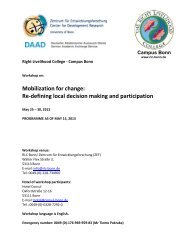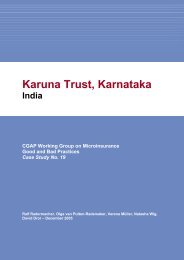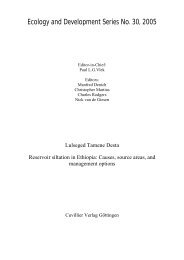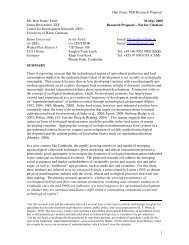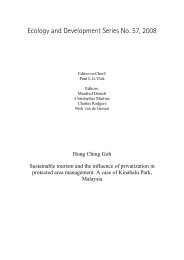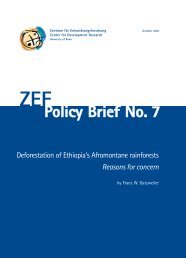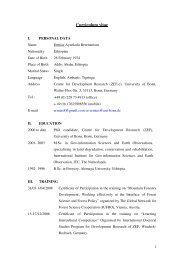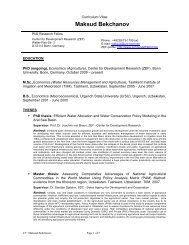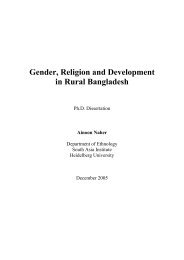Ecology and Development Series No. 10, 2003 - ZEF
Ecology and Development Series No. 10, 2003 - ZEF
Ecology and Development Series No. 10, 2003 - ZEF
- No tags were found...
Create successful ePaper yourself
Turn your PDF publications into a flip-book with our unique Google optimized e-Paper software.
Impacts of human use on the forest vegetationabundant than the other plant species. The abundance of coffee was omitted in order tocompare the contribution of non-coffee plant species to the vegetation structure.Because, inclusion of coffee in the abundance data contributes only slightly to the totalabundance of the NATFOR <strong>and</strong> SECFOR. On the other h<strong>and</strong>, in the managed forestcategories coffee overwhelmingly dominates (as high as 50%) due the low abundance ofother species. In the structural analysis, plants were grouped into four major heightclasses (HC): HC 1 (< 1.5 m tall), HC 2 (1.5-12.5 m), HC 3 (12.5-24.5 m), <strong>and</strong> HC 4(>24.5 m). This height class with different ranges was used to capture the existingconditions of the forest vegetation structure with respect to coffee. The first class, HC1,represents seedlings <strong>and</strong> young saplings that are too small for diameter measurement,<strong>and</strong> does not contribute to the basal area. The stems or individuals in the HC2 includeshrubs, saplings <strong>and</strong> the majority of small trees. Individuals in the HC2 occupy a similarheight class with mature coffee trees <strong>and</strong> hence are the ones that compete with coffeefor space. Height classes HC3 <strong>and</strong> HC4 constitute shade trees in lower <strong>and</strong> uppercanopy layers.5.2.2 Analysis of differences in species compositionThe difference in the mean number of species per plot among the studied forestcategories was tested using one-way analysis of variance (ANOVA). One-way ANOVAis similar to the t-test except that it allows comparison of more than two groups ofdatasets. In order to test how one forest category differs from another, the Mann-Whitney-U-test was used. The U-test is the nonparametric equivalent of the independentsamples t-test <strong>and</strong> is recommended for counting data such as number of species <strong>and</strong>abundances of this kind.The Shannon index was calculated using the software EstimateS 6.01b(Colwell 2000). The Shannon index represents the information statistic indices of themeasures of heterogeneity. It takes into account the evenness of the abundances ofspecies. Additionally, Shannon evenness (E) was calculated as the ratio of the Shannondiversity index (H) to the maximum diversity (H max ). The value of H max is the naturallogarithm of the number of species (Magurran 1988).The relationship of the number of species <strong>and</strong> abundance can be used to detectthe prevalence of human intervention in a community, using species abundance models.71



